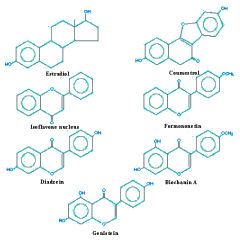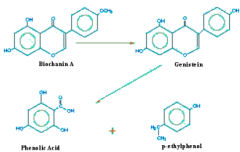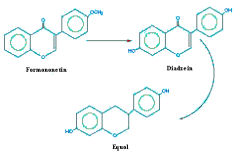Phytoestrogens (Coumestans and Isoflavones)
Phytoestrogens are plant estrogens. When consumed by livestock they exhibit estrogenic activity and may hamper reproductive performance. Clovers such as subterranean clover (Trifolium subterran) and red clover (Trifolium pratense) generally contain isoflavones. Alfalfa (Medicago sativa)contains coumestrans.
Subterranean Clover( Trifolium subterran)
Subterranean clover is a winter annual grown in the northwest regions of the U.S. as a winter and spring pasture crop. It pushes its seeds down into the ground upon maturity and thus reseeds itself. Its seeds can remain dormant for many years making it difficult to eradicate once established in a pasture.
How Poisoning Occurs

Similarity of plant estrogens to estradiol

Metabolism of the isoflavones, biochanin A and genistein, in the rumen.

Metabolism of the isoflavones, formononetin and diadzein, in the rumen.
Certain water soluble glucosides in plants bear a close resemblence to estradiol and are known as plant estrogens. Clovers synthesize isofavones such as biochanin A, daidzein, formononetin, and genistein from phenylalanine, while alfalfa synthesizes coumestans from cinnamic acid. Although formononetin has about half, one third, and one quarter the estrogenic activity of biochanin A, diadzein, and genistein, respectively, negative estrogenic effects on sheep appear to be directly correlated to the formononetin content of the clover forage. This is because rumen microorganisms degrade genistein and biochanin A to p-ethylphenol and phenolic acids, thus destroying their estrogenic effects. However, rumen microorganisms demethylate formononetin to daidzein, and then together with any daidzein directly consumed from the clover, these minor phytoestrogens are metabolized to equol which is a much more potent form of estrogen. Absorbed equol is rapidily excreted in the urine of cattle, but not in sheep. Thus sheep are much more susceptible to the estrogenic effects of isoflavones. Isoflavines alter the responsiveness of the animal tissue to endogenous estrogen. High serum levels of phytoestrogens may also inhibit the release of gonadotropic hormones from the pituitary gland and fill receptor sites in the cervix and uterus meant for endogenous estrogens.
Symptoms of Poisoning
The cervix of a ewe exposed to high formononetin clover cultivars undergoes morphological changes. The cervical folds fuse together so that the cervical tissue resembles uterine tissue. During breeding season, the cervix and vagina fail to to respond to endogenous estrogen stimulation and temporary infertility results because of reduced ability of the sperm to penetrate the oviduct. This is because the cervical mucus does not undergo its normal changes or "priming"to aid sperm longitivity in the cervix. After 24 hours, the amount of viable sperm present in the cervix is only about 5% of that found in a healthy cervix. Ovulation generally occurs following standing heat so this reduced longevity of sperm can have serious consequences on conception rates. The condition may become permanent if the ewe remains on these forages for prolonged periods of time.
Cattle that are exposed to alfalfa cultivars with high contents of coumestans may experience cystic ovaries and irregular heat cycles. Dairy heifers may exhibit precocious mammary and genital development.
[Clovers (Trifolium spp.)] [How poisoning occurs] [Symptoms of poisoning] [Return to list of toxicants]